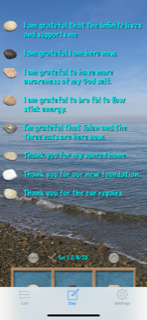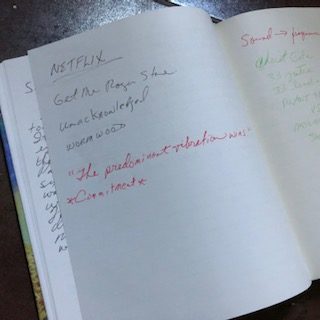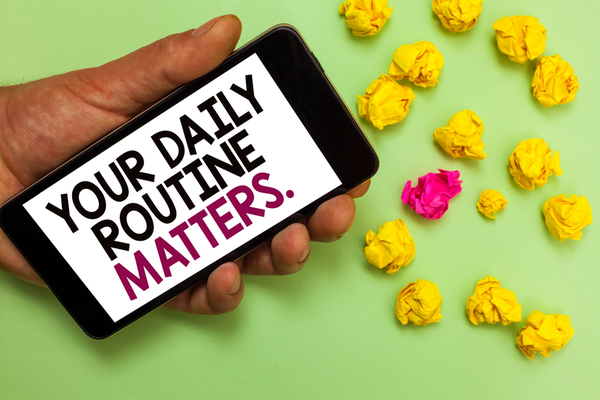I originally wrote this blog for Dr. Carolyn Dean’s blog. Since we all develop habits, I want to encourage you to choose those habits that support and reinforce your gains. So, I offer you this updated version of the blog, Hacking Daily Rituals.
Update of Hacking Daily Rituals
Good evening! Melody-Rose here. I’m writing on my byline tonight. When our communications team talked to Dr. Dean the other week, we realized how many of the habits we talk about that contribute to the creation of good health (keeping a health journal, doing a treasure map, learning how to do your own research) also are factors in creating success in every endeavor. That’s why we think this post, Hacking Daily Rituals, could be very valuable for you and your loved ones.
My first mentor, a man who literally coached thousands of people who went on to achieve financial success and time freedom, often said:
Today I will do what others won’t…so, tomorrow I can do what others can’t.
What he meant when he said that is that achievers have daily habits that foster success and go beyond what the average person generally is willing to do. Successful people focus on preparing, planning, doing, and contributing more. This value-added mindset is what sets them apart.
Daily Rituals For Beginners
I grew up in a blue-collar environment. My parents were hard workers, but they showed up for work on time, did their job well, and left at the end of the day. They came home, had family dinner, and watched television. Monday through Friday, they “lathered, rinsed and repeated” this pattern. Then, on Saturday, they did grocery shopping and errands. On Sundays we had a big family dinner and watched football. What did we know about expanding our success? Not much. It wasn’t until I was in my late 30s that I finally was exposed to success coaches and entrepreneurial thinking. So, it is never too late to start your success journey.
Everyone wants to be, do, and have more. But if you are like me, your question for this post is, “Where do I start?” I personally would start by developing a daily ritual because it will give you a solid, grounded framework for implementing other success habits. If you would like to learn how to put your daily ritual together, I invite you to join me and read on.
What Is a Daily Ritual?
In 7 Daily Rituals of Highly Successful People, Time Management Expert Adrian Shepherd, explains a daily ritual like this:
Will Durant wrote two of the best books on history ever – The Lessons of History and The Story of Philosophy. In the latter, he wrote when discussing Aristotle’s philosophy that “We are what we repeatedly do. Excellence, then, is not an act, but a habit.”
Highly successful people understand this better than anyone. They realize that the small daily habits we have play a major role in our success. So just what do they do differently?
Daily Rituals Used by Successful People
Gratitude Journal. In our post, I Want to Turn This Situation Around but It’s Too Hard, I describe using my Gratitude Journal:
Even if I am in the depths, I will grab my Gratitude Journal and write down 5 things I’m grateful for. In fact, when I’m going through a rough patch, I make it a disciplined habit to write 5 things I’m grateful for in the morning and 5 things I’m grateful for before I go to bed, even if I repeat items.
Almost every success coach I’ve ever studied with or read about has emphasized the importance of waking up in the morning and writing in your Gratitude Journal. Here is a photo of the Gratitude Journal I have on my iPhone:

Journaling. In her post, Treasure Mapping and Journaling for Health, Dr. Dean gave this description of the power of journaling:
People have journaled since ancient times. Think of cavemen drawing on the walls of caves to memorialize their interactions with the world. This was their journal. Think how powerful this tool is considering the very earliest records of man were created in this way.
Thrive Global, an organization developed to help people deal with stress at work so that they don’t develop burnout and can be more creative, shared:
Ever wondered why history’s great minds including Isaac Newton, Abraham Lincoln, Andy Warhol, Leonardo Da Vinci, Marcus Aurelius, Charles Darwin, Winston Churchill, Benjamin Franklin, Ernest Hemingway, George Bernard Shaw and Maya Angelou would spend so much of their precious time writing things that will never be seen by another soul?
One of the most prolific podcasters and success coaches, Tim Ferris, calls journaling:
the deloading phase in life…. I use it as a tool to clarify my thinking and goals, much as Kevin Kelly (one of my favorite humans) does. The paper is like a photography darkroom for my mind.
I often use the Notes app on my iPhone so that if ideas come to me when I’m out of the house, I can write them down. When I’m at home, I still prefer my paper journal.

Treasure Mapping. In the same post, Dr. Dean talks about making a treasure map. She said:
I was first exposed to treasure mapping when I read Shakti Gawain’s book, Creative Visualization, in the late 1970s. Since that time, visualizing goals has become accepted as an effective success practice. Treasure mapping (sometimes called, “creating a vision board”) is a fun way to learn to visualize while eliminating resistance to change.
Jane Alexander, journalist and author, describes a treasure map as:
a large piece of paper covered with images that reflect a goal, a desired outcome, your ultimate dream. The idea is that, by giving your subconscious a graphic blueprint of what you want and need, it will work at ways of making that a reality.
Mental Rehearsal. You can make treasure mapping even more powerful by adding mental rehearsal to the time you spend looking at your treasure map. Scott Williams of Wright State University says:
Mental rehearsal of performances is an excellent way to support skill development. LeaderLetter subscribers have told me that they’ve found mental rehearsal useful for job interviews, presentations, cheerleading performances, athletic performances, sales calls and teaching. There are numerous opportunities to use mental rehearsal to master managerial behaviors too.
We are all familiar with Olympic athletes who mentally rehearse winning the Gold, like Missy Franklin:
When I get there, I’ve already pictured what’s going to happen a million times,” said swimmer Missy Franklin, who won four gold medals at the London Games, “so I don’t actually have to think about it.
Why don’t you take advantage of mental rehearsal, too, with the help of your treasure map? How I use mental rehearsal with my treasure map is that I’ll take 5 extra minutes before I leave my bedroom (where my treasure map hangs on the back of my bedroom door) and scan my treasure map. If any particular wish/desire/goal/dream jumps out at me, I focus on that part of the treasure map. Then, I imagine myself there already and ask myself these questions, what do I:
- see?
- hear?
- taste?
- feel?
- smell?
I get all five sentences involved and make what I imagine more and more real in my mind by strengthening my sensory experience of the scene. When I smile and feel a sense of satisfaction/excitement, I say out loud, “Thank you, God.” Then, I spend a minute or two writing about the experience in my journal.
Meditation. Dr. Dean wrote about meditation and prayer in Module 73 of the Completment Now Health Program, because she knows that creating good health, success, or any other desire is facilitated by meditation. Since I love multi-tasking (and Dr. Dean does, too), I thought I’d share the section on Walking Meditation:
I’m not going to make a list of the benefits of meditation because they are much the same as prayer – giving you a greater sense of awareness and possibility in your life. When I think of walking meditation, I imagine doing it outdoors. But some people walk indoors for any number of reasons: terrain, inclement weather or privacy. As I mentioned I can’t sit still long enough to do sitting meditation, so I practice walking meditation. It’s probably the best way for beginners to start meditating. It occupies your fidgety body and gives your eyes new scenes to observe but not necessarily engage.
Walking Meditation
Here are some suggested components of a walking meditation. There are no “rules.” It’s the last place you want to worry that you’re not doing it “right.” There is no right or wrong, there is only you with your intent to meditate and the rest will take care of itself.
- Try to give yourself a minimum of 15 minutes to allow yourself to receive the benefit of slowing down your mind.
- You can set your pace at a fast, normal or slow walking speed. Some people find that a slow pace is more contemplative.
- Walk with your body loose. Check in with your muscles and try not to hold any tension as you swing your arms gently and stride along smoothly. Every once and a while do a mini slump to relax your whole body.
- Be mindful of each step.
- You may or may not want to focus on your breath. For some it can be a way to still the mind by focusing on the circular flow of your breath.
- Or you may count your breaths in and out. One-two-three-four breathing in and one-two-three-four breathing out.
- You can count your steps with each breath for another way of introducing a “mindless” activity.
- Although you aren’t necessarily focused on exercising during your walking meditation, don’t be surprised if your lung capacity improves and you are able to take deeper and longer breaths.
- Your body is loose, and your eyes should also be relaxed and not trying to judge everything you see. Don’t let your mind comment on what you are looking at beyond appreciating what you see.
- Cultivate an Inner Smile and an Outer Smile. I first heard the term inner smile from Mantak Chia, a famous Qi Gong teacher. He talks about circulating the energy in your body and evoking an inner smile. I say you can begin with an outer smile at the marvel of your body and allow that smile to touch your inner organs.
- Most meditation books talk about walking in silence, no vocalization and no inner voice chattering.
- That’s where I break ranks with the meditators because I like to sing to the angels as I walk.
- So, maybe I’m in the prayer section after all!
- If you choose to do your walking meditation indoors, adopt a relaxed strolling posture. I gently hold my hands behind my back and scuff/walk very slowly with my eyes on the floor. I immediately feel calm and just concentrate on my breathing and counting steps.
Reading. Read at least 15 minutes every night before you go to bed from a positive book, particularly one from which you are learning new concepts or skills. One of my favorite starter books is Think and Grow Rich by Napoleon Hill.
Learning. Become a lifelong learner. Attend conferences and seminars; watch videos; listen to podcasts; watch factual television and movies.
Breathwork. In Dr. Dean’s post, My Loved One Can’t Breathe…, she describes the benefits of learning how to breathe and how to use abdominal breathing to improve your breathwork:
Abdominal breathing is also called diaphragmatic breathing because your diaphragm moves down as you inhale. When babies and animals breathe, their whole body seems to be involved and their abdomens rise and fall with each breath.
I catch myself sometimes with a tense abdomen and take a conscious abdominal breath to release it. When I was growing up, the emphasis was on posture, not breathing, which made me throw my shoulders back, tense my abdomen and suck in my stomach — the military posture. Then there was all that tight clothing that people wore in the 60’s and 70’s. Girdles were all the rage. How can you possibly breathe with all that rubber and elastic squeezing the life right out of you?
With half the population in bathing suits here on Maui, I see a lot of abnormal breathing because people are trying to suck in their wayward stomach. I don’t know if this is the only reason. Perhaps that and the stress and fear that we allow to pervade our lives makes us tense and inhibits our breathe. Many years ago, I learned about abdominal breathing during my naturopathic training.
Exercise. Dr. Dean, in her post Do I Have to Exercise to Be the One My Partner Fell In Love with? gives 38 different exercises you can choose from to add to your daily exercise ritual.
Nightly to Do List. If you have trouble getting to sleep, Dr. Dean recommends writing down tomorrow’s To Do List tonight. That way you have dumped all the activities you would normally think about instead of sleeping on paper. This often helps people relax into sleep.
Sleep. Take a warm bath or shower before when you get ready for bed. Do your nightly To Do List and five Gratitude Statements in your journal. Read from your positive book for at least 15 minutes. Then, turn off all electricity in your room. You can meditate quietly or do progressive relaxation so that you fall asleep in a relaxed state.
Summary
Since I love Dr. Dean’s health perspectives, I have kept the links to her blogs in this post. As her ghost writer, I feel very proud of the number of beginners to health freedom we have been able to reach with this information.
We’ve given you some ideas of success strategies that you can include when you create your daily ritual. There certainly are dozens more out there to choose from. But the most important thing is choosing a few that attract you, that you would like to try. Get started right now!!!
